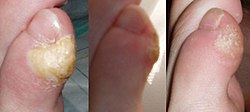Callus

Editor-In-Chief: Prab R Tumpati, MD
Obesity, Sleep & Internal medicine
Founder, WikiMD Wellnesspedia &
W8MD medical weight loss NYC and sleep center NYC
| Callus | |
|---|---|

| |
| Synonyms | Callosity, tyloma |
| Pronounce | N/A |
| Specialty | Dermatology |
| Symptoms | Thickened and hardened area of skin |
| Complications | Pain, infection |
| Onset | Gradual |
| Duration | Variable |
| Types | N/A |
| Causes | Repeated friction, pressure, or irritation |
| Risks | Poorly fitting shoes, manual labor |
| Diagnosis | Based on physical examination |
| Differential diagnosis | Corn (medicine), Plantar wart, Keratoderma |
| Prevention | Proper footwear, protective pads |
| Treatment | Pumice stone, Salicylic acid, Orthotics |
| Medication | Topical keratolytics |
| Prognosis | Good with treatment |
| Frequency | Common |
| Deaths | N/A |
<languages /><translate>
- Callus is a thickened and hard area of skin due to consistent pressure or friction.
- A callus may also refer to the area around a bone break where new bone is formed.
- While caluses usually form on the bottom of the feet, corns form on the top.

Pathophysiology[edit]
- Calluses grow on the bottom of the foot or on the outer edge of a toe or heel.
- A callus may spread across the ball of your foot.
- This type of callus is usually due to a problem with a metatarsal - the long bone at the base of a toe, near the ball of the foot.
- A pinch callus may grow along the outer edge of the heel or the big toe.
- Some calluses press up into the foot instead of spreading on the outside.
- A callus may form a central core or plug of tissue where pressure is greatest.

Purpose[edit]
The thickening of the skin is a protective reaction.
Symptoms[edit]
- Skin is thick and hardened.
- Skin may be flaky and dry.
- Hardened, thick skin areas are found on hands, feet, or other areas that may be rubbed or pressed.
- The affected areas can be painful and may bleed.
Investigations[edit]
The diagnosis is usually made by history and physical examination and tests are not needed.
Treatment[edit]
Preventing friction is often the only treatment needed.
- Calluses often occur due to excess pressure placed on the skin because of another problem such as bunions or hammertoes.
- Proper treatment of any underlying condition should prevent the calluses from returning.
- Wear gloves to protect your hands during activities that cause friction to help prevent calluses.
Prognosis[edit]
- Corns and calluses are rarely serious.
- They should improve with proper treatment and not cause long-term problems.
Complications[edit]
- Complications of corns and calluses are rare.
- People with diabetes are prone to ulcers and infections and should regularly examine their feet to identify any problems right away.
| Diseases of the skin and appendages by morphology | ||||||||||||||||||||||||||||||||||||||||||||||||||||||
|---|---|---|---|---|---|---|---|---|---|---|---|---|---|---|---|---|---|---|---|---|---|---|---|---|---|---|---|---|---|---|---|---|---|---|---|---|---|---|---|---|---|---|---|---|---|---|---|---|---|---|---|---|---|---|
|
Ad. Transform your life with W8MD's Budget GLP-1 injections from $75


W8MD offers a medical weight loss program to lose weight in Philadelphia. Our physician-supervised medical weight loss provides:
- Weight loss injections in NYC (generic and brand names):
- Zepbound / Mounjaro, Wegovy / Ozempic, Saxenda
- Most insurances accepted or discounted self-pay rates. We will obtain insurance prior authorizations if needed.
- Generic GLP1 weight loss injections from $75 for the starting dose.
- Also offer prescription weight loss medications including Phentermine, Qsymia, Diethylpropion, Contrave etc.
NYC weight loss doctor appointmentsNYC weight loss doctor appointments
Start your NYC weight loss journey today at our NYC medical weight loss and Philadelphia medical weight loss clinics.
- Call 718-946-5500 to lose weight in NYC or for medical weight loss in Philadelphia 215-676-2334.
- Tags:NYC medical weight loss, Philadelphia lose weight Zepbound NYC, Budget GLP1 weight loss injections, Wegovy Philadelphia, Wegovy NYC, Philadelphia medical weight loss, Brookly weight loss and Wegovy NYC
|
WikiMD's Wellness Encyclopedia |
| Let Food Be Thy Medicine Medicine Thy Food - Hippocrates |
Medical Disclaimer: WikiMD is not a substitute for professional medical advice. The information on WikiMD is provided as an information resource only, may be incorrect, outdated or misleading, and is not to be used or relied on for any diagnostic or treatment purposes. Please consult your health care provider before making any healthcare decisions or for guidance about a specific medical condition. WikiMD expressly disclaims responsibility, and shall have no liability, for any damages, loss, injury, or liability whatsoever suffered as a result of your reliance on the information contained in this site. By visiting this site you agree to the foregoing terms and conditions, which may from time to time be changed or supplemented by WikiMD. If you do not agree to the foregoing terms and conditions, you should not enter or use this site. See full disclaimer.
Credits:Most images are courtesy of Wikimedia commons, and templates, categories Wikipedia, licensed under CC BY SA or similar.
Translate this page: - East Asian
中文,
日本,
한국어,
South Asian
हिन्दी,
தமிழ்,
తెలుగు,
Urdu,
ಕನ್ನಡ,
Southeast Asian
Indonesian,
Vietnamese,
Thai,
မြန်မာဘာသာ,
বাংলা
European
español,
Deutsch,
français,
Greek,
português do Brasil,
polski,
română,
русский,
Nederlands,
norsk,
svenska,
suomi,
Italian
Middle Eastern & African
عربى,
Turkish,
Persian,
Hebrew,
Afrikaans,
isiZulu,
Kiswahili,
Other
Bulgarian,
Hungarian,
Czech,
Swedish,
മലയാളം,
मराठी,
ਪੰਜਾਬੀ,
ગુજરાતી,
Portuguese,
Ukrainian


